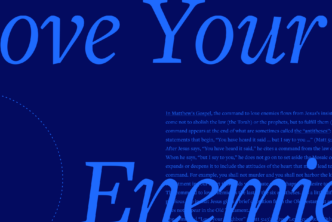There are certain passages that make you scratch your head, even if you’ve read them before.
Luke 11:24–26 is one of them.
Here’s how Joel Green, author of the Luke volume in the New International Commentary of the New Testament (NICNT), treats verses 23–26. We include his comments and footnotes so you can dive deeper into the argument and get a sense for how NICNT works.
Commentary on Luke 11:23–26:
It is not enough for Jesus merely to deflect the misrepresentation of his ministry as diabolic in origin (v 15) nor even to assert and explain the true significance of his practices of exorcism. Because his ministry is the focal point of the eschatological clash between God’s salvific project and satanic opposition (vv. 20–22), it is imperative, even urgent, that people align themselves for battle.
This message is communicated, first, in the form of a two-part axiom, with both parts oriented toward the same point but employing different metaphors. In a co-text marked by conflict and invective rhetoric, Jesus’ audience is first charged to declare their loyalties in the battle (cf. Josh 5:13). [1] If the initial image is militaristic, the second is agricultural, pointing to the gathering of God’s people. [2] What is remarkable is that the side on which one chooses to engage the struggle is fundamentally determined by how one responds to Jesus; suddenly, Jesus’ concern to legitimate himself with reference to common wisdom and his similarity to other exorcists is overridden by this assertion of his distinctiveness.
Verses 24–26 make much the same point, though in a less direct way. Jesus’ words read like “an extract from a textbook on demonology”[3]—that is, as though he were going over what would have been standard ideas about the behavior of unclean spirits.[4] This would presumably have included, for example, such notions as the following: demons are capable of independent existence apart from a host; having been cast out of a person,[5] spirits range over desert regions;[6] they prefer to indwell human beings; and humans are capable of being possessed by multiple spirits.[7]
Why does he rehearse these apparently common views? First, Jesus thus develops a striking contrast between the work of the exorcist through whose activity the kingdom of God is rendered present and that of the world of evil spirits; the one leads to a life[8] that is clean and in order, the other to destruction.[9] Second, this comparison renders all the more pressing the need not only to enjoy the benefits of Jesus’ ministry (as the crowds have thus far been doing)[10] but positively to respond in ongoing faithfulness (cf. 8:11–15).
- The co-text of the analogous saying in 9:50 is quite different.
- Cf. 3:17; also the image of gathering (and scattering) the flock of Israel in Isa 11:12; 40:11; Ezek 5:12; 34:13, 21; Zech 11:16; Tob 3:4.
- F. Evans, 494; cf. Page, Powers of Evil, 172. Some (e.g., Godet, 2:67–69; Marshall, 479) have argued that in vv 24–26 Jesus is characterizing the ineffectual ministries of exorcism of other Jewish exorcists (as in v 19). But there is no hint of any censure of those exorcists in v 19, nor does Jesus specify who is responsible for the exorcism of the unclean spirit in v 24.
- On the association of “unclean spirits” and “demons,” see above on 4:33.
- Nolland (2:645) believes that the spirit leaves of its own accord: “As the spirit was free to leave, so the spirit is free to return …,” but the linguistic evidence on which he bases this reading is fallacious. He insists that Luke uses the language of “departure” rather than “expulsion”; however, ἐξέρχομαι is used to describe the departure of demons who have been commanded to depart by Jesus the exorcist in, e.g., 4:35; 8:2.
- Of the texts often adduced as supporting this representation of the proclivities of demons, only Isa 34:14–15 LXX; 4 Macc 18:8 appear to be somewhat relevant; Bar 4:35 refers to a desolate locale, which seems to be the point of “waterless regions.” Cf. Str-B 4.1.516.
- See 8:2, 30.
- The spirit refers to “my house”—i.e., its domicile, a human being. This metaphorical use of οἶκος was anticipated in the parabolic use of “castle” (αὐλή, “courtyard” or, by synecdoche, “house” or “mansion”) in v 21.
- Kilgallen (“Return of the Unclean Spirit”) argues that the function of vv 24–26 is to continue Jesus’ defense by contrasting the nature of Jesus’ ministry with the work of the demonic. The contrast he notes is helpful. In our view, however, Jesus’ defensive strategy included only the material in vv 17–19; with vv 20–26 he has moved on to a positive reinterpretation of his practices of exorcism, situating them within the context of the struggle of two kingdoms, in light of which appropriate response is now urgent.
- Cf. 13:26–27; 17:11–19.
So what can we surmise from this commentary?
According to Green, Jesus is describing a practice of an exorcized spirit: to wander the desert seeking rest. The “house” the spirit returns to is the human host, and it reenters with seven spirits more evil to make that person’s possession even worse than it was before.
The verse may puzzle us at first read, but upon reflection we remember—as many of us are prone to forget—that we live in a spiritual world among spiritual forces, and that a prominent aspect of Jesus’ ministry was to cast out such darkness, as he did in Luke 11:14.
The point the text is making is that Jesus casts out darkness not by the power of Beelzebul, but “by the finger of God”—an act of kingdom expansion (11:20).
For more scholarly insights on Scripture, browse the NICOT/NICNT volumes.







